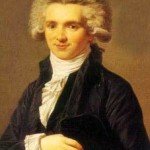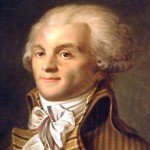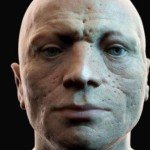 Maximilien François de Robespierre (1758-1794) was the most significant leader of the French Revolution’s radical period. Robespierre has divided historians and modern thinkers, just as he divided opinion in his own time. Some consider him the revolution’s greatest dictator, the arch ‘sanguinocrat’, the driving force behind the Committee of Public Safety (CPS) and the Reign of Terror. Others have taken a more nuanced and measured view of Robespierre, believing his power and influence have been exaggerated and misrepresented. Whatever the extent of his power, Robespierre is a fascinating figure. Obsessed with virtue and incorruptibility, disinterested in material gain and distractions, Robespierre was a man entirely dedicated to the revolution.
Maximilien François de Robespierre (1758-1794) was the most significant leader of the French Revolution’s radical period. Robespierre has divided historians and modern thinkers, just as he divided opinion in his own time. Some consider him the revolution’s greatest dictator, the arch ‘sanguinocrat’, the driving force behind the Committee of Public Safety (CPS) and the Reign of Terror. Others have taken a more nuanced and measured view of Robespierre, believing his power and influence have been exaggerated and misrepresented. Whatever the extent of his power, Robespierre is a fascinating figure. Obsessed with virtue and incorruptibility, disinterested in material gain and distractions, Robespierre was a man entirely dedicated to the revolution.
Robespierre was born in Arras, about 115 miles (180 kilometres) north of Paris, in 1758. His mother died when Robespierre was an infant and his father abandoned the family shortly after, leaving Robespierre and his siblings to be raised by their grandparents. He attended a local school and proved an exceptional student, winning a scholarship to Paris. There he shared classes with Camille Desmoulins, who for much of the revolution was a political ally. As a 16-year-old Robespierre was chosen to deliver a Latin eulogy to the newly crowned Louis XVI – but the king famously snubbed young Robespierre, remaining in his carriage out of the rain then leaving early. By the early 1780s, Robespierre had graduated with a law degree and returned to Arras where he worked as a defence lawyer. He became one of the region’s best advocates, taking on and winning some high profile cases and frequently working pro bono (‘for the public good’) on behalf of those who could not pay.

Robespierre’s political life began in 1789 when he was elected to represent the Third Estate of Artois at the Estates General. Radical in his views, he was one of the first to join the Breton Club (a forerunner to the Jacobin club) and, later, the National Assembly. Robespierre’s influence in the National Constituent Assembly was overshadowed by the oratorical power of men like Honore Mirabeau and Jean-Sylvain Bailly. He was more effective behind the scenes, however, and came to exert considerable influence in the Jacobin club. Robespierre did not sit in the Legislative Assembly (he famously raised the self-denying ordinance that prevented this) but was elected to the National Convention in September 1792. Robespierre was an avid believer in republicanism, democracy, equality and the ideas of Jean-Jacques Rousseau. In his first months in the Convention, Robespierre expressed his opposition to slavery in the French colonies, to a declaration of revolutionary war in Europe, to the use of capital punishment and the excessive use of violence. But like the revolution itself, his views would change and radicalise with time.

Robespierre’s profile and influence increased during the autumn of 1792. His policies and speeches became popular with the sans-culottes of Paris, who admired Robespierre’s democratic values and his regular assertions that the revolution belonged to the people, not the politicians. Robespierre’s opponents blamed him for igniting the September Massacres; the accusation was baseless, though he later justified the massacres as a legitimate revolutionary action. Within the Convention, Robespierre became a prolific leader of the Montagnard faction. His speeches, like much of his political career, divided opinion. Robespierre was undoubtedly eloquent and his speeches were rigorously prepared – but they did not please everyone. “He is too verbose and does not know when to stop”, one observer noted. Robespierre himself was cold, humourless, single-minded and difficult to like. He had few friends and never married, despite constant offers from women he did not know. The historian Thomas Carlyle called him the “sea-green incorruptible”. Georges Danton‘s coarse view of Robespierre was that he “can’t fuck and money scares the hide off him”.
“Robespierre’s politics have often been seen as synonymous with the Revolution itself. He encapsulated what was best – and worst – about the Revolution. He was a tireless advocate for liberty and equality, yet, to defend these principles, he was prepared to adopt the Terror. Nevertheless, he was only one man amongst many, and we may ask why it is that revolutionary ideology as a whole has so often been identified with this one individual.”
Marisa Linton, historian
Robespierre spent the first half of 1793 plotting against the Girondins, whose orators still dominated the National Convention. In the spring of 1793, Robespierre took this fight to the Jacobin club where he urged the people to take action against Jacques Brissot and his followers. Robespierre’s incitement paid off on June 2nd when an uprising of the National Guard and the sans-culottes forced the expulsion of 29 Girondin deputies from the Convention. Though Robespierre had played an important role in orchestrating this, he later claimed it as an expression of the popular will. With his Girondinist opposition gone, Robespierre’s influence began to increase. In late July 1793, he gained election to the Committee of Public Safety (CPS) and became the committee’s spokesman on the floor of the Convention.

This is where uncertainty about Robespierre’s power begins. While undoubtedly an influential figure on the CPS, it is unlikely he dominated the Committee as is often assumed. Robespierre’s ideas, actions and leadership played a critical role in bringing on the Reign of Terror. Seeking to extend their control over the revolution, and under pressure from the Parisian sans-culottes, Robespierre and his colleagues on the CPS made “terror the order of the day”. Together they engineered the Law of Suspects (September 1793), which provided a legal basis for the Terror; the Decree on Emergency Government (October 1793), which suspended the constitution and individual rights; and the Law of Frimaire (December 1793), which further centralised government power in the hands of the CPS. Robespierre justified these measures with a number of speeches in late 1793 and early 1794. He equated revolutionary terror with virtue because it cleansed and secured the nation.

Robespierre could be as ruthless as he was single-minded. He used the CPS and the organs of the Terror to eradicate many of his rivals, most notably Georges Danton (April 1794). On his way to the guillotine, Danton predicted that Robespierre would soon be following him – and so it proved to be. Robespierre’s fall from grace was the product of several miscalculations. By mid-1794, Robespierre was unpopular both with his fellow deputies and many Parisians, a fact suggested several assassination plots against him. Robespierre’s attempt to create an artificial religion, the Cult of the Supreme Being, with himself at the helm, invited accusations of megalomania. Finally, the passing of the Law of 22 Prairial, which expanded and escalated the Terror, drove many of Robespierre’s politicians into a panic. A loose coalition began plotting to purge Robespierre before he could purge them. The end came on July 27th 1794 when Robespierre and his followers were cornered in the Hôtel de Ville. Shot through the jaw, Robespierre was hauled away and guillotined the next day. His death signalled a rapid and profound transformation in the revolution, the end of the Reign of Terror and the beginning of the Thermidorian Reaction.

1. Maximilien Robespierre was the most significant revolutionary leader of the radical period (1792-94), a critical figure in the Committee of Public Safety (CPS) and an architect of the Reign of Terror.
2. Raised by his grandparents, Robespierre was an outstanding student once famously snubbed by King Louis XVI. He obtained a law degree and returned to his native Arras, where he excelled as a lawyer.
3. Robespierre represented the Third Estate at the Estates-General, where he proved an important though not prominent figure. He was also active in the Breton and Jacobin clubs.
4. Robespierre’s rise to national fame began during his time in the National Convention. He became a significant Montagnard leader and was admired by the sans-culottes for his democratic values.
5. Robespierre was a key figure in the CPS. His power increased with the passing of laws that centralised power and unfurled the Reign of Terror. Robespierre’s championing of the Cult of the Supreme Being, as well as his personal demeanour and arrogance, led to his growing unpopularity. He was eventually overthrown and guillotined in July 1794.

Robespierre on what should be done with the deposed king (1792)
Robespierre urges the government to support continued insurrection (1793)
Robespierre justifies the use of revolutionary terror (1794)
Robespierre on the relationship between virtue and terror (1794)
Robespierre pays homage to France’s ‘new god’: the Supreme Being (1794)
An account of the arrest of Robespierre (1794)
Madame de Staël on the power of Robespierre and the CPS (1798)
© Alpha History 2018. Content on this page may not be republished or distributed without permission. For more information please refer to our Terms of Use.
This page was written by Jennifer Llewellyn and Steve Thompson. To reference this page, use the following citation:
J. Llewellyn and S. Thompson, “Maximilien Robespierre”, Alpha History, accessed [today’s date], https://alphahistory.com/frenchrevolution/maximilien-robespierre/.
